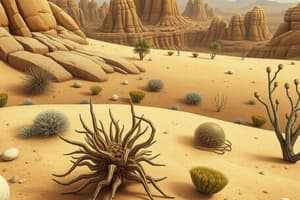Podcast
Questions and Answers
Terrestrial ecosystems are always located on land, while aquatic ecosystems are always located in water.
Terrestrial ecosystems are always located on land, while aquatic ecosystems are always located in water.
True (A)
Adaptations in organisms are solely physical traits, and do not include any behavioral traits.
Adaptations in organisms are solely physical traits, and do not include any behavioral traits.
False (B)
Biodiversity refers only to the number of different species present in an ecosystem, and does not include genetic diversity or the range of ecosystems.
Biodiversity refers only to the number of different species present in an ecosystem, and does not include genetic diversity or the range of ecosystems.
False (B)
Ecosystems are always classified into either terrestrial or aquatic categories, and there are no other types of ecosystems.
Ecosystems are always classified into either terrestrial or aquatic categories, and there are no other types of ecosystems.
Ecological concepts like population dynamics, competition, and predation are not considered key concepts in the field of ecology.
Ecological concepts like population dynamics, competition, and predation are not considered key concepts in the field of ecology.
Protecting and conserving biodiversity is not important for maintaining healthy ecosystems and providing essential ecosystem services.
Protecting and conserving biodiversity is not important for maintaining healthy ecosystems and providing essential ecosystem services.
Classification is primarily concerned with the organization of living beings based on their physical appearances.
Classification is primarily concerned with the organization of living beings based on their physical appearances.
The Linnaean system assigns each species a unique name consisting of three parts: genus, species, and kingdom.
The Linnaean system assigns each species a unique name consisting of three parts: genus, species, and kingdom.
Ecology focuses on understanding the interactions among organisms but does not consider their environment.
Ecology focuses on understanding the interactions among organisms but does not consider their environment.
Ecosystems study the distribution, abundance, and changes in populations of living organisms only.
Ecosystems study the distribution, abundance, and changes in populations of living organisms only.
Adaptations refer to the process of living beings changing their environment to suit their needs.
Adaptations refer to the process of living beings changing their environment to suit their needs.
Biodiversity refers to the variety and variability of living organisms and their ecological complexes.
Biodiversity refers to the variety and variability of living organisms and their ecological complexes.
Flashcards are hidden until you start studying
Study Notes
The Living World: Classification, Ecology, Ecosystems, Adaptations, and Biodiversity
In the realm of environmental studies, the concept of the 'living world' is a central theme that encapsulates various aspects related to ecosystems, biodiversity, and the intricate relationships between life forms and their environment. This article will delve into the subtopics of classification, ecology, ecosystems, adaptations, and biodiversity within the context of the living world.
Classification
Classification refers to the organization of living beings based on shared characteristics. In the study of biology, classifying organisms helps scientists understand the evolutionary relationships among various species and to predict the behavior and physiological traits of individual species. One popular method is the Linnaean system, developed by Carl Linnaeus, which assigns each species a unique name consisting of two parts: a genus (capitalized) and a species (lowercase). For instance, humans belong to the genus Homo and species sapiens. This hierarchical system allows for efficient communication and understanding among researchers worldwide.
Ecology
Ecology is the scientific study of interactions among organisms and their environment. It focuses on understanding the distribution, abundance, and changes in populations of living organisms, as well as their interactions with physical factors such as climate, weather patterns, and geography. Key concepts in ecology include population dynamics, competition, predation, symbiosis, and mutualism. By studying ecology, we can better understand how human activities affect the natural world and develop strategies to preserve and conserve biodiversity.
Ecosystems
An ecosystem is a complex network of interacting organisms and their physical environment. It includes all the living things in a particular area, including plants, animals, and microorganisms, as well as the non-living factors such as soil, water, and air. Ecosystems can be classified broadly into terrestrial (land-based) and aquatic (water-based) categories. Examples of terrestrial ecosystems include forests, grasslands, and tundra. Aquatic ecosystems include freshwater systems like streams and ponds, as well as marine environments like oceans and coral reefs. The health and functioning of ecosystems are essential for maintaining biodiversity and supporting the services and resources that humans rely on, such as food, clean air, and water.
Adaptations
Adaptations are physical or behavioral traits that help organisms survive and reproduce in their specific environments. These traits have evolved over time through a process called natural selection, where individuals with advantageous traits are more likely to survive and pass on their genes to the next generation. Examples of adaptations include camouflage in animals to blend in with their surroundings, the ability of some plants to photosynthesize more efficiently in high-altitude environments, and the use of tools by some animals to access food or build shelters. Understanding adaptations helps us appreciate the diversity of life on Earth and the amazing ways in which organisms have evolved to thrive in their respective habitats.
Biodiversity
Biodiversity refers to the wide variety of life on Earth, including the number of different species, genetic diversity within those species, and the range of ecosystems they inhabit. It is crucial for maintaining healthy ecosystems, providing essential ecosystem services such as pollination, nutrient cycling, and climate regulation. Additionally, biodiversity offers numerous cultural, aesthetic, and recreational values. Humans depend on biodiversity for food, medicine, fiber, fuels, and many other products and resources. However, biodiversity is under threat from habitat destruction, invasive species, pollution, and climate change. Protecting and conserving biodiversity requires awareness, education, and action at local, national, and international scales.
Studying That Suits You
Use AI to generate personalized quizzes and flashcards to suit your learning preferences.




